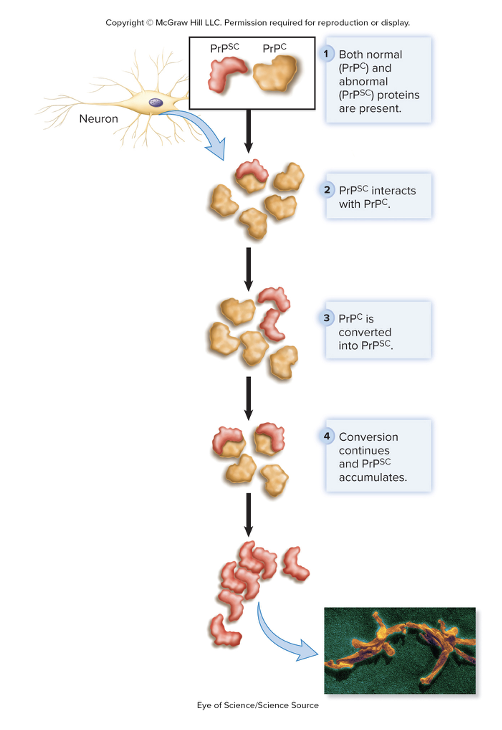CH. 13 - Viruses and Prions
1/52
There's no tags or description
Looks like no tags are added yet.
Name | Mastery | Learn | Test | Matching | Spaced |
|---|
No study sessions yet.
53 Terms
Virus
a non-living, infectious particle
includes naked viruses and enveloped viruses
Naked Viruses
composed of a capsid which surrounds the nucleic acid
capsids can also be a nucleocapsid
Many have spike proteins projecting off their surface
Help virus attach to specific receptors on host cell

Capsid
Protein coat composed of subunits called capsomeres
can be isometric (icosahedron), helical, or complex
Nucleocapsid
Capsid + nucleotide = nucleocapsid
Isometric (icosahedron) Capsid
looks like a geometric 3D shape
very common

Helical Capsid
cylinder shaped

Complex Capsid
looks kinda like a robot with spider legs
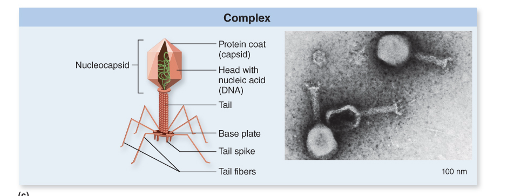
Enveloped Viruses
A naked virus surrounded by a lipid bilayer
Lipid bilayer is called an envelope
Virus doesn’t make its bilayer, it steals a section of its host cell and wraps it around itself
Matrix proteins line the interior of the lipid bilayer and have a function in releasing the virus from the host cell
Many have spike proteins projecting off their surface
Help virus attach to specific receptors on host cell
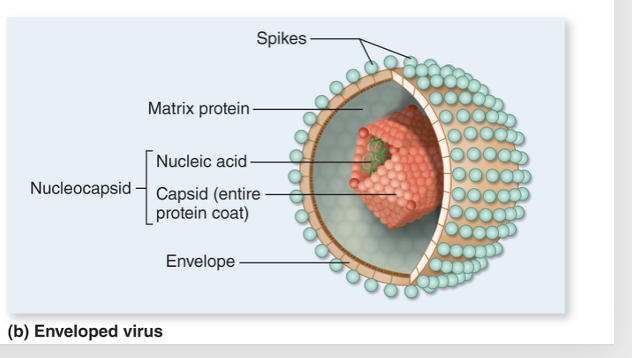
Virus Structure and Size
Viruses have nucleic acids
can be DNA or RNA, but never both
can be single or double stranded, but never both
viral DNA can be circular or linear
viral RNA can only be linear
Viruses are 100 to 1,000x smaller than the cells they infect
10nm – 500nm
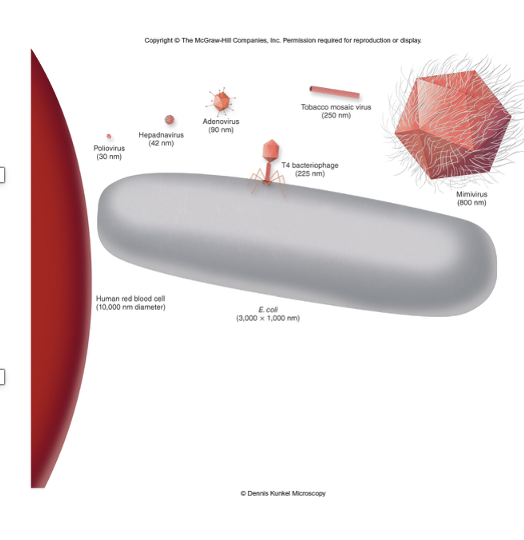
Virus Replication
Viruses dont have enough genetic info to self replicate, so they essentially force host cells to do it for them
this makes them obligate intracellular parasites
Viruses are very specific to host cells they infect
Specificity is due to the attachment of the virus
Host cell has to have a receptor that the virus can bind to
means they are host/tissue specific
Will use host cell machinery to assemble viral specific molecules instead of the normal macromolecules it makes
Obligate Intracellular Parasites
This means that outside of the host cell, they are just a particle
Once they attach to a host cell and get their genetic info, they can force host cells to produce viral cells
Host Tropisms
Viruses that are specific to a host and cant infect other types of hosts
ex) A virus that infects cats but cant be passed to humans
Tissue Tropisms
Viruses that attach to receptors only found in a specific tissue type
Ex) flu virus only attaching to cells in respiratory tissue
Virus/Host Cell Interaction Flow Chart
a virus infects a host cell
either disease of the host cell or genetic alteration of host cell occurs
if disease of host cell occurs, we get a productive infection, and more virus is produced
when these viruses are released, 2 things can happen: either the host cells lyse, or the host cells don’t lyse
If the host cell lyses, it dies. If the host cell does not lyse, it multiplies, causing the continuous release of virions (chronic infection)
if genetic alteration of the host cell occurs, the host cell experiences a latent state
In this latent state, the viral DNA is integrated into the host cell genome, but no new viral particles are being produced
Then, the host cell will multiply, but the phenotype is changed because of the viral genes that are integrated in the chromosome, causing the cell to not work right

Productive Infection
an infection that results in the production of more viral particles
Chronic Infection
When host cell doesn’t die and continues to produce viruses
Bacteriophage Lytic Replication
Replication that ends in the lyse of the host cell
Achieved in 5 Steps:
Attachment
Genome Entry
Synthesis
Assembly
Release
All viruses are essentially going to use these 5 steps
Attachment in Bacteriophage Lytic Replication
Bacteriophage attaches to specific receptors on the bacteria
mediated by tail fibers

Genome Entry in Bacteriophage Lytic Replication
Injection of the the bacteriophage DNA into the bacterial cell
bacteriophage is going to change shape and inject its nucleic acid into the bacterial cell
They don’t enter the cell, they inject their nucleic acid into the cytoplasm of bacterial cell
Now the genetic info can be expressed once in cytoplasm
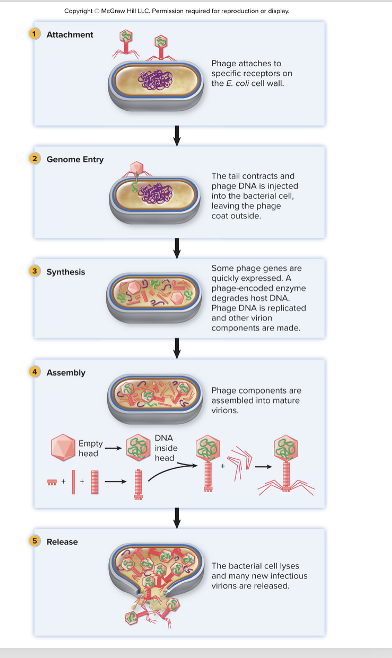
Synthesis in Bacteriophage Lytic Replication
In this stage, bacterial machinery makes all the parts we need to make a new bacteriophage
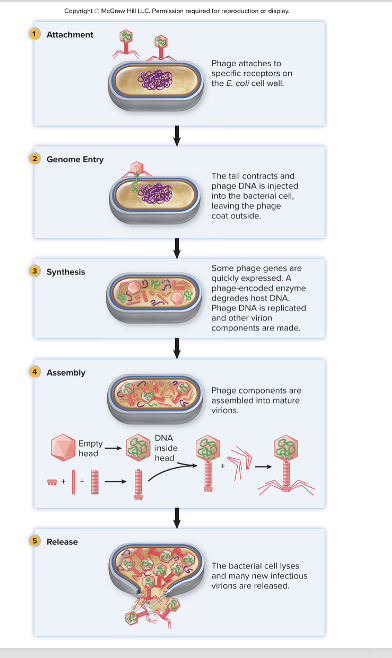
Assembly in Bacteriophage Lytic Replication
In this stage, we start to put all the pieces together to assemble a mature/active bacteriophage
Bacteriophage assembly doesn’t require proteins or enzymes, it happens automatically
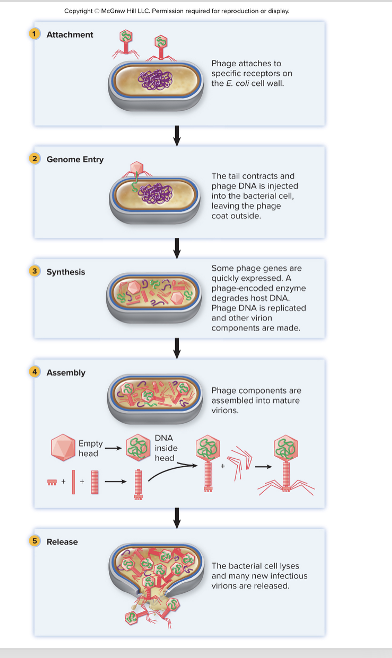
Release in Bacteriophage Lytic Replication
Where we release the assembled bacteriophage by lysing the host cell (break it open to release the bacteriophage)
bacteriophage has lysozyme to break through the cell wall and lyse the cell, releasing the bacteriophage
Then it will float around and look for a new host cell to infect
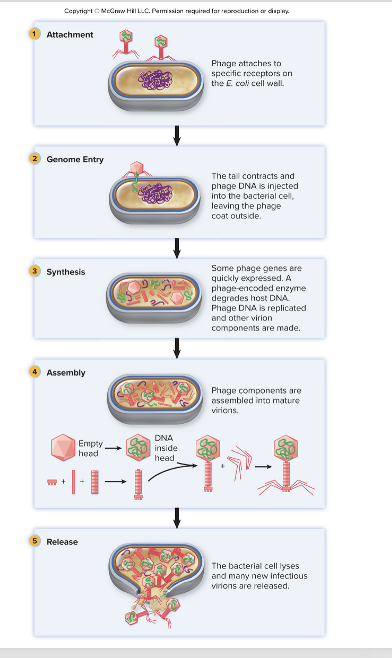
Lysogeny
bacteriophage attaches to surface of bacterial cell and injects its nucleic acid
Bacteriophage has to make a decision of lytic replication or lysogeny
If it chooses lysogeny…
Genetic info is inserted into bacterial chromosome
This creates a lysogen, which is a cell in a state of lysogeny (latent state)
When the bacteriophage genetic info is integrated in the bacterial chromosome, it’s called a prophage
Once lysogeny is established, the bacterial cell will go about its normal business of growing and dividing
Each time it divides it replicates chromosome, also replicating the bacteriophage DNA
All the daughter cells will have it as well
Lysogeny can last indefinitely
If there is damage to the host cell, that bacterial cell will die and take the bacteriophage with it
So, if the bacterial cell looks like it might die, the bacteriophage will leave the bacteria and try to find a host cell where it can complete lytic replication
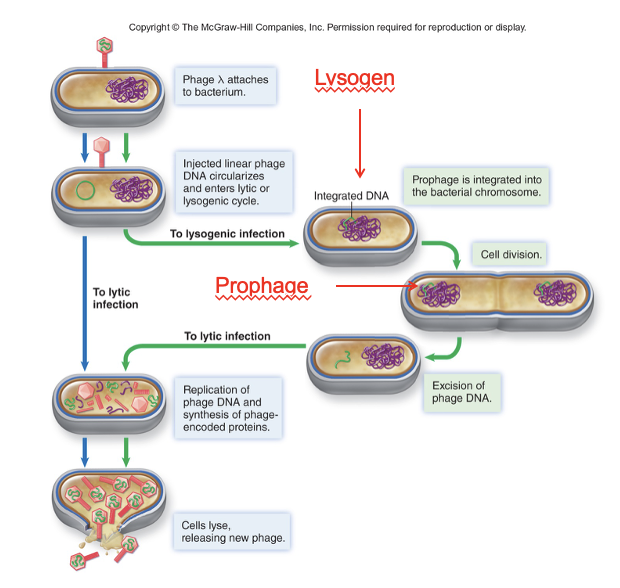
What type of bacteriophage uses lysogeny?
Only temperate bacteriophages use lysogeny
Lysogenic Conversion
the process where a lysogenic bacteriophage transfers genes that encode toxins to a bacteria
This new genetic information is often carried on a prophage
Bacteria carrying the prophage will produce the toxins/virulence factors, which cause disease
There are a number of diseases caused by bacteria that have undergone lysogeny
Streptococcus pyogenes (scarlet fever)
Clostridium botulinum (botulism)
Corynebacterium diphtheriae (diphtheria)
Bacteriophage in Transduction (General and Specialized):
Transfer of bacterial genetic information using bacteriophage
Generalized Transduction
Bacterial chromosome is chopped into little bits and a random piece is packages inside a bacteriophage to make that transducing particle
Specialized Transduction
Only occurs during lysogenic infections
Prophage takes some of bacterial DNA when leaving the chromosome
Packaged into virions
The DNA that can be transferred during specialized transduction is only the DNA next to where the prophage is located
Bacteriophage Specialized Transduction
Variation of transduction that only occurs if donor cell is in a state of lysogeny
A temperate bacteriophage injects its DNA into the host cell
bacteriophage DNA is integrated into the host cell chromosome, creating a prophage
When this bacteriophage DNA isnt cut out correctly, we then have a piece of DNA that is part bacteria and part virus
When you make new bacteriophages, they will have the hybrid piece of DNA
This is the transducing particle
This replication creates defective viral particles
Bacteriophage injects the hybrid molecule into a bacterial cell
Bc it doesn’t have all the bacteriophage genes, no new viruses can be made
The bacteriophage DNA is degraded, and the bacterial DNA is integrated into the cell
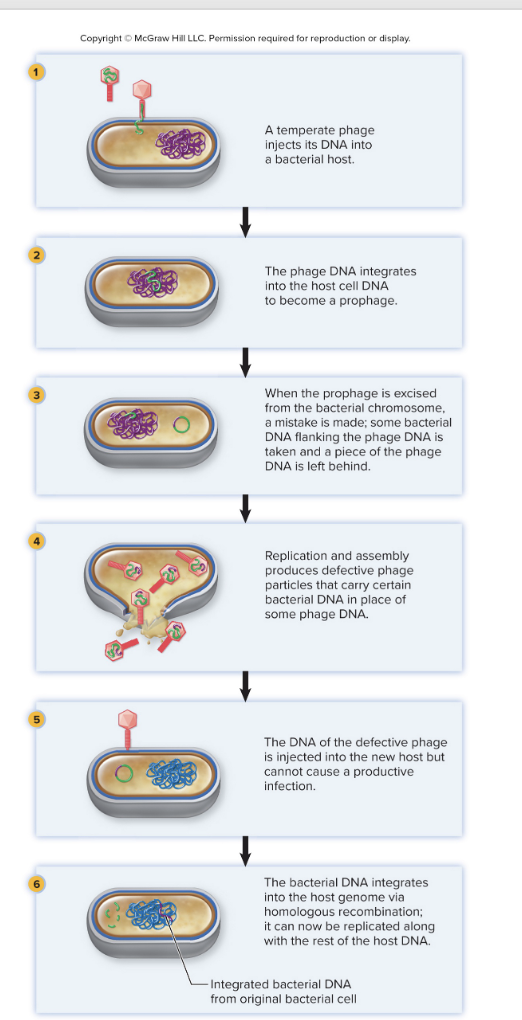
Features of Viruses used to Classify Animal Viruses
Genome Structure
DNA or RNA
Single or double stranded
single molecule or segmented
Virus Particle Structure
isometric (geometric 3D shape)
helical (cylinder shape)
pleomorphic (irregular non-geometric shape)
Presence or Absence of an Envelope
Classification of Animal Viruses (Family, Genus, Species):
Family
Family name ends in -viridae
Based on genome, virus structure, envelope
Genus
Genus name ends in -virus
Enterovirus, Rhabdovirus, Coronavirus
Species
Name usually derived from disease caused: poliovirus, ebola virus, influenza virus
5 Steps of Animal Virus Replication
Attachment
Penetration and Uncoating
Synthesis
Assembly
Release
Attachment in Animal Virus Replication
Virus attaches to receptor on host cell
Protein spikes on virus recognize and bind to specific glycoproteins on the host cell
Once the virus is attached, we need to get viral DNA inside
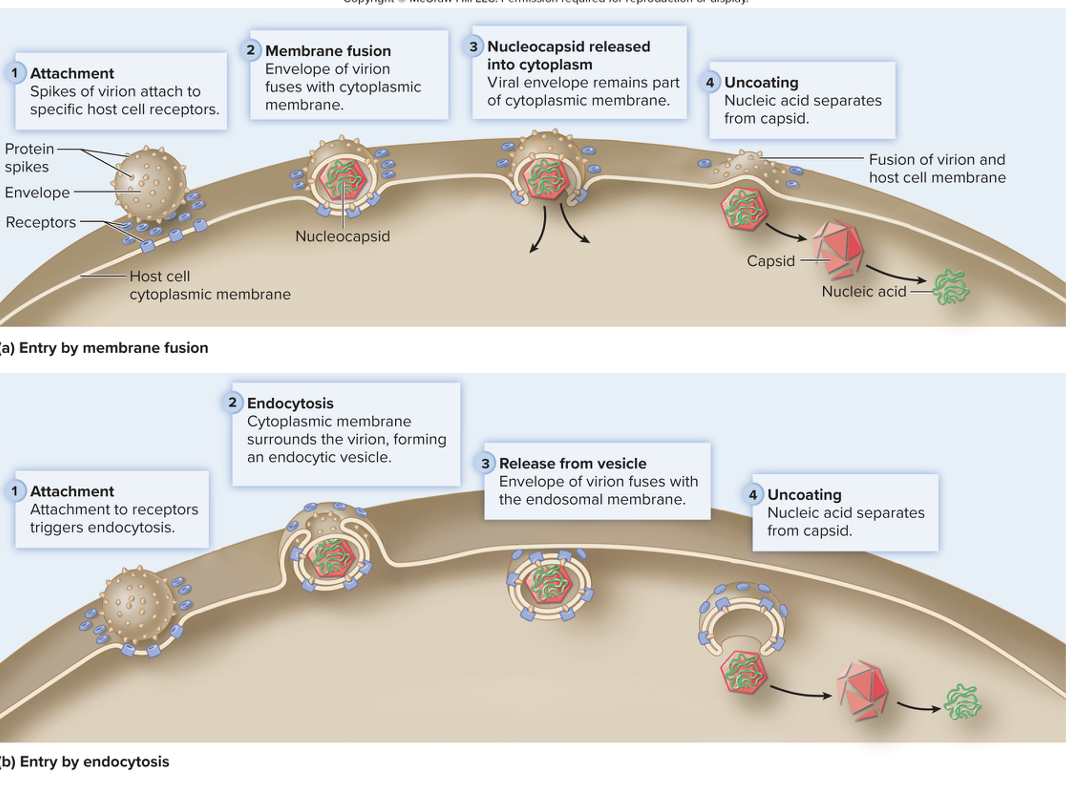
Penetration and Uncoating in Animal Virus Replication
If it’s an enveloped virus…
they can fuse with the cell membrane of host cell, or they can enter through endocytosis (cell membrane wraps around the virus and internalize it)
If a naked virus….
only enters through endocytosis
In both cases, the viral particle is inside the host cell and needs to release its nucleic acid
To do this, they degrade the viral particle to release the nucleic acid (called uncoating)
Synthesis in Animal Virus Replication
The nucleic acid has to be targeted to the right place in animal cell so that synthesis of the viral particles can occur
DNA viruses go to the nucleus
RNA viruses go to the cytoplasm
Assembly in Animal Virus Replication
When we put together all the pieces to form a viral particle
For enveloped viruses, assembly. .
puts together a nucleocapsid
modifies a section of the host membrane with viral proteins
Lines the interior with matrix proteins which serve as a docking center to show the nucleocapsid where it should attach
Release in Animal Virus Replication
To release itself from the host cell, enveloped viruses…
Go through budding where it pushes through this part of the membrane with the matrix proteins. Membrane wraps around nucleocapsid, and then we release the new enveloped virus
Can also leave through exocytosis
gets its membrane from some internal membrane bound organelle, then leaves through exocytosis
Some will lyse the host cell to exit
Naked viruses…
Can only leave through exocytosis
Some viruses will lyse the host cell and exit that way as well
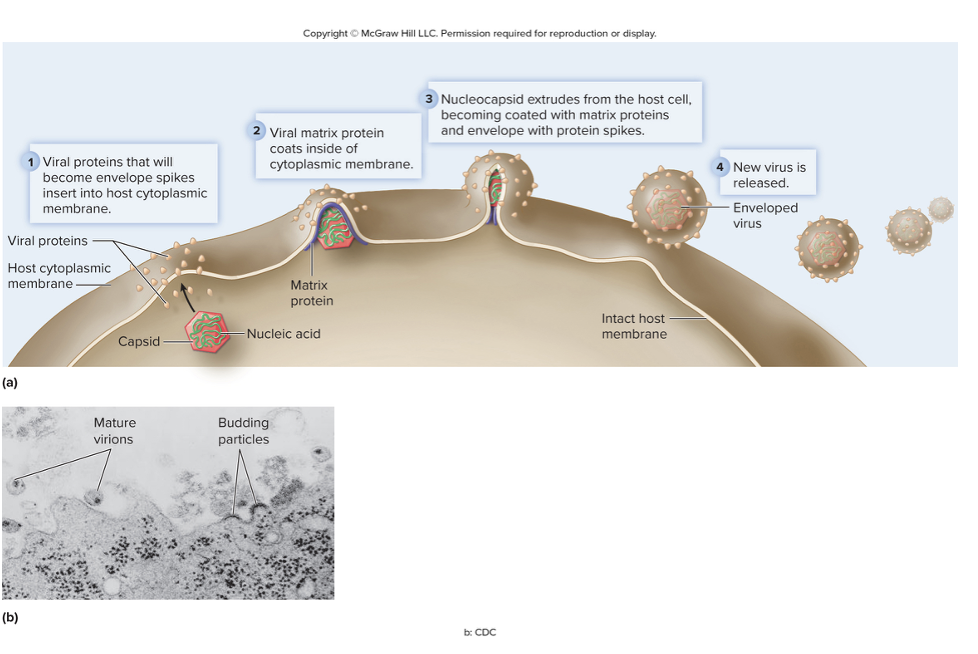
Shedding
The process by which the virus leaves the host animal to be spread to a new animal
Viruses can be shed through the respiratory tract, urinary tract, etc
Usually leave the same way they entered
Transmission
The way that a virus enters into a new host
ex) droplets, skin contact, bodily fluids, etc
Acute Infections
are short in duration (days to months)
The infected cells will die
The virus is shed during the infection and possibly transferred to new individuals
Usually, the infected host will recover and develop immunity (cant be infected by that exact virus again)
Stages of Acute Infections:
Prodromal stage
Infected with virus, reproducing virus, capable of passing on the virus, but not experiencing symptoms, may feel a little off towards end
Disease stage
Suffering noticeable symptoms
Immune system is responding
Convalescent stage
Starting to fell better
Immune system is eliminating the virus
Still infectious

Persistent Infections
Last for a long period of time
a lot are caused by enveloped viruses
May or may not cause a disease
people with persistent infections are carriers of the virus
2 categories:
Latent Infections
Chronic Infections
Latent Infections
Animal virus infects host cell and causes a state of latency
so the cell is infected, but during latent state no new viruses are being made
Stages of Latent Infections
You become exposed, and the virus multiplies
Period of active symptoms
Then you recover and are non-infectious, but the virus is still in you
Immune system eliminates viral particles, but latency has been established, so some cells still hold viral genetic info
Reactivation of the virus can happen later and cause you to experience active symptoms again

Chronic Infections and the Stages of Infection:
Continuous production of the virus
Symptoms can be short in duration, but cells are still infected and you still continue to produce and release viruses for a long time

How can viruses cause cancer?
They make changes to the cell and cell proteins so that it undergoes unregulated cell division, leading to tumors
Tumor (neoplasm) and its cause:
Swelling/lump caused by abnormal cell growth
Cause:
The non-functioning or malfunctioning of a protein that serves an essential role in cell growth/division
Benign Tumor Vs. Malignant Tumor
Benign tumor: tumor remains confined to a defined region
Malignant tumor: tumor spreads (metastasizes) to other parts of body
Proto-oncogenes
Genes that encode for proteins that function in the regulation of cell growth or differentiation
If mutated, it is called an oncogene, which will then encode mutated forms of this protein, resulting in cancer
Viral Transformation
aka the conversion of a normal cell into a cancer cell
Viruses inject DNA that carry oncogenes
This leads to the expression of oncogenes
Causes dysregulation in cell division, creating a cancer cell
Transformation increases probability of cancer, it doesn’t always cause cancer
How do viruses transform cells?
Through the actions of retroviruses
Retroviruses
RNA viruses that become proviruses when they infect cells
When they infect a cell, they convert their RNA into DNA using enzyme reverse transcriptase
The DNA is then inserted into the chromosome of the host cell
Once inserted into chromosome, its called a provirus
Retrovirus carries oncogenes which can be expressed and cause cancer (unregulated cell growth) in that cell
What is viral host range and how is it determined?
Host range is the range of hosts a virus can infect
Determined by the attachment step / the host cell receptors
Virus can only infect host cells if the host has the right receptor that it can recognize and bind to
Some viruses can infect multiple hosts
Cells can be infected with more than one virus type at a time
This makes it possible for the two viruses to swap bits of genetic info
Can result in a virus being able to infect a new type of host
ex) Pigs can be infected by bird flu and human flu
If they are infected with both, genetic exchange can happen between the viruses, so now the bird virus is capable of infecting humans (
called an antigenic shift
Prions
Proteinaceous infectious particles
basically just infectious proteins
If exposed to a prion, the prion can convert your normal proteins into prion proteins, causing a progressive neurodegenerative disease that is 100% fatal
Cause Transmissible Spongiform Encephalopathies (TSE’s)
ex) mad cow, Kuru, Scrapie, Creutzfeldt-Jacob disease
Are highly resistant to heat, chemicals, and radiation, making them almost indestructible
Mainly acquired through consumption / handling of contaminated items
some forms can be genetic
No treatment known
Replication of Prions
If you consume a prion protein, it will go to the CNS and interact with the normal protein and convert it into a prion protein
they keep doing that until you have a lot of prion proteins in the CNS, causing neuro-degeneration
In order for replication to happen, the normal protein (PrP C) must be present
The mutated form of the protein is called PrPSC
Types of prions usually stay within specific species
sometimes they can be spread between species, like Mad Cow disease
It takes a long time after the initial exposure to exhibit symptoms (takes months to years)
